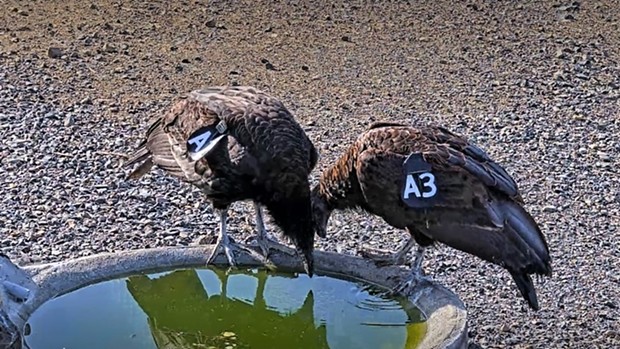News Blog
New Cohort of Condors Set to Arrive in Humboldt

- Yurok Tribe Facebook
- A2 and A3 interact after A3 returns to the enclosure site after a two-week absence.
This new group of the largest birds in North America, which boast a nearly 10-foot wingspan and the ability to soar for more than 100 miles a day on thermals, will join four others already flying free in the skies of Humboldt County as part of the Northern California Condor Restoration Program, a partnership between the tribe and Redwood National and State Parks, which plans to reintroduce a new group of prey-go-neesh every year for at least the next two decades.
"In May, the NCCRP released the first of four condors to fly over Yurok skies in more than a century, " the NCCRP Facebook post states. "The fourth bird was reintroduced to the wild in July. The birds include: Hlow Hoo-let (A1), Ney-gem' 'Ne-chween-kah (A0), Poy'-we-son (A3) and Nes-kwe-chokw' (A2). Monitored seven days a week, the young condors are flourishing in the redwood region. The birds consistently exhibit healthy behaviors, such as feeding, soaring, and finding safe roosts."
On May 25, the sole female, A0, joined the group,and was given the name "Ney-gem' 'Ne-chween-kah," which means, "She carries our prayers."
After being screened, the arriving three males and one female will be placed into the NCCRP’s Condor Release and Management Facility with mentor bird No. 746, where they can be viewed live on the Yurok Condor Cam at
Read more about the condor restoration program in the Journal's June 23 cover story here. (Just a note, when the story went to print A0 had been on a long sojourn but she later returned to management and release site.)
Read the NCCRP release below:
NCCRP To Receive Second Condor Cohort – Four More Condors Expected To Be Released In September/October
On the morning of Tuesday, August 16, the Northern California Condor Restoration Program (NCCRP) will receive four more prey-go-neesh (California condors). The Yurok Condor Restoration Program Manager and Yurok Wildlife biologists, in collaboration with veterinarians from the Sequoia Park Zoo, Oregon Zoo and Oakland Zoo as well as representatives from Redwood National and State Parks (NPS) and Yurok-affiliated technicians from the Great Basin Institute, will perform a health assessment on each condor. Staff from Pinnacles National Park will be on site too.
Once the health evaluation is complete, the birds will be placed into the NCCRP’s Condor Release and Management Facility, where they can be viewed live on the Yurok Condor Cam. Here is a link to the Condor Cam: https://www.yuroktribe.org/yurok-condor-live-feed
The young bird’s will acclimatize in the Condor Release and Management facility for approximately one month prior to their staggered release into the wild. The new condor cohort is comprised of one female and three males. Two of the nearly two-year-old birds were reared at the Oregon Zoo’s breeding facility. The The World Center for Birds of Prey raised the other two.
The NCCRP expects to implement a staggered release of the birds between mid-September and mid-October, but the timing is ultimately contingent upon condor readiness as determined by NCCRP’s biologists. The NCCRP is a partnership between the Yurok Tribe and Redwood National and State Parks (RNSP). The NCCRP plans to reintroduce one cohort of prey-go-neesh every year for at least the next two decades.
In May, the NCCRP released the first of four condors to fly over Yurok skies in more than a century. The fourth bird was reintroduced to the wild in July. The birds include: Hlow Hoo-let (A1), Ney-gem' 'Ne-chween-kah (A0), Poy'-we-son (A3) and Nes-kwe-chokw' (A2). Monitored seven days a week, the young condors are flourishing in the redwood region. The birds consistently exhibit healthy behaviors, such as feeding, soaring, and finding safe roosts.
The Yurok Tribe and Prey-go-neesh
The Yurok Tribe initiated the condor reintroduction project in 2008. With funding support from Redwood National Park, the U.S. Fish and Wildlife Service, the Bureau of Indian Affairs, the Administration for Native Americans, as well as Pacific Gas and Electric Company, Global Conservation Fund, the Redwood National Park Foundation, and many more corporate, agency and private supporters and citizens, the Yurok Wildlife Department completed a vast volume of work to prepare for the reintroduction of this imperiled species.
Working in collaboration with the Ventana Wildlife Society, Redwood National Park, the California State Parks, and Pacific Gas and Electric Company, as well as volunteers, the Tribe designed and constructed the NCCRP release and management facility. The flight pen includes a simulated, shock-wired power pole (to teach the birds to avoid this threat after release), two four-foot diameter pools and a perch overlooking old-growth redwood forest. NCRRP staff are present seven days a week to monitor the birds from custom-modified shipping containers which form a fire-resistant observation structure.
The facility is also is designed to allow biologists and technicians to conduct regular health evaluations and provide treatment if required.For the Tribe, the restoration of this sacred species is part of a larger effort to rewild the temperate rainforest ecosystem in Yurok ancestral territory on the far Northern California coast.
In addition to the reintroduction of the critically endangered condor, the Tribe is currently restoring fish and wildlife habitat on large sections of the Klamath River, Trinity River and Prairie Creek as well as other Klamath tributaries. The Tribe is also intimately involved in the pending removal of the Klamath dams, which represents the largest river restoration project in US history. The removal of the dams will benefit a wide diversity of fish and wildlife species, including condors.
Comments
Showing 1-1 of 1